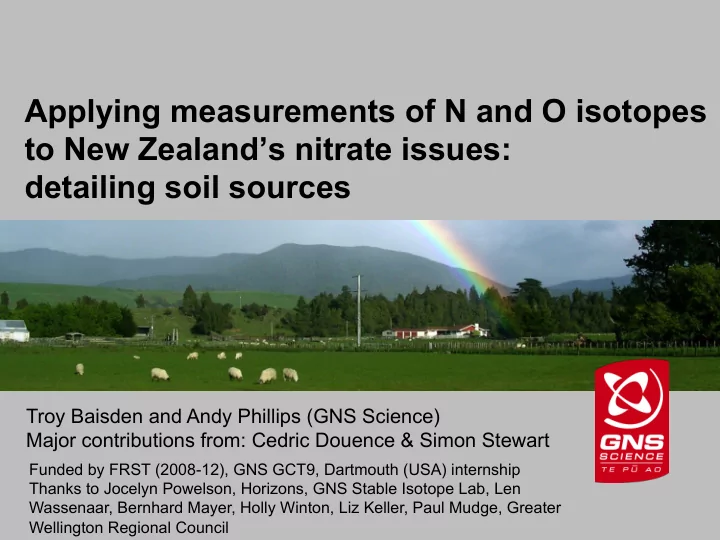

Applying measurements of N and O isotopes to New Zealand’s nitrate issues: detailing soil sources Troy Baisden and Andy Phillips (GNS Science) Major contributions from: Cedric Douence & Simon Stewart Funded by FRST (2008-12), GNS GCT9, Dartmouth (USA) internship Thanks to Jocelyn Powelson, Horizons, GNS Stable Isotope Lab, Len Wassenaar, Bernhard Mayer, Holly Winton, Liz Keller, Paul Mudge, Greater Wellington Regional Council
Where the N & O isotopes in NO 3 come from in most of New Zealand … 2 Drivers of lower δ 18 O: Urine spots • Higher elevation nitrate production • Winter nitrification • Nitrate production on irrigated land NH 4 + ½ O 2 + 2 H 2 O • Sewage treatment + photosynthetic O Sources of higher δ 18 O: • Nitrification in summer/evaporation NO 3 • Nitrate-bearing fertilizer Developed method for NZ δ 15 Ν and δ 18 O to <0.3‰ Blank ≤ 5 ppb 2 GNS Science
δ 18 O δ 15 N GNS Science GNS Science
In NZ, δ 15 N reflects intensity & duration of agriculture 4 Mudge et al 2013 SSSAJ Winchmore Archived Soil Samples PhD student Paul Mudge δ 15 N (‰)
Upper Manawatu Catchment: Pasture Dominated GNS Science
Upper Manawatu – Pasture Streams & Rivers 10 8 6 δ 18 O – NO 3 4 Nov-10 2 Mar-11 May-11 0 Jul-11 -2 -4 -6 -2 0 2 4 6 8 10 12 14 δ 15 N – NO 3 GNS Science
Why the Mangatarere? • Ideally a smaller catchment was needed with: – Groundwater understanding – Interesting sources of nitrate to streamwater – Closer to our institute – Ability to identify hidden sources in the field using DO, EC, and temperature. GNS Science
~140 km 2 Mangatarere Catchment Headwaters Pastoral + Effluent Sources Piggery Masterton Fault Effluent Carterton Fault Town of Carterton Sewage & Landfill Mangatarere Stream Larger N-limited Waiohine River Graphic: GWRC report 8 GNS Science
13-17 February 2012 Mangatarere Low Flow Campaign 11.0 δ 15 N-NO 3 (‰) Bend 7.0 into GW Piggery STP flow Effluent 3.0 2.0 Anom (‰) Local δ 18 O 0.0 -2.0 -4.0 NO 3 (g/m 3 ) 2.0 1.0 Carterton 0.0 Fault Masterton 5 10 15 20 Fault Distance d/s of Gorge (Km) GNS Science
Mangatarere Stream: Seasonal Bifurcation? 8.0% 6.0% November% 2010% δ18O%NO3(‰)+ 4.0% δ 18 O – NO 3 (‰) Winter%2011% 2.0% January%2011% 0.0% Jan%2012%Storm% !2.0% Large summer δ 18 O anomaly Summer%2012% in upper catchment samples !4.0% 0.0% 5.0% 10.0% 15.0% δ15N%NO3(‰)+ δ 15 N – NO 3 (‰) GNS Science
A useable tool to track sources and denitrification where impacts matter 10 Negl. Atmospheric NO 3 ; From Local Few Fertilizer NO 3 Sources 8 DAM Line: calculate δ 18 O – NO 3 (‰) 6 δ 18 O anomaly 4 Sewage Treatment 2 (Photosynthetic) 0 -2 -4 Food Web -6 -2 0 2 4 6 8 10 12 14 δ 15 N – NO 3 (‰) GNS Science
Summary? Area 1 20 Nitrate Fertiliser Area 2 Effluent 15 δ 18 O-NO 3 (‰) 10 5 0 Soil Water Typical Effects -5 Effluent & Septic Forest & Pasture Streams -10 -5 0 5 10 15 δ 15 N-NO 3 (‰) Water isotopes provide an important additional tracer. GNS Science
A long process … Targeted Applied Operational Basic Science Monitoring Science • 1+ PhD Students • Initial Applications to Policy & Management • Investigations GNS Science
Recommend
More recommend